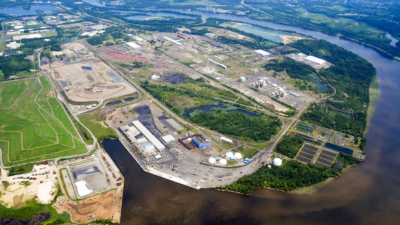While COVID-19 continues to dominate headlines, the U.S. industrial sector remains stable, as first quarter 2020 activity remained on pace with activity recorded one year ago. Occupier appetite for bulk space is elevated due to steady demand for industrial space, especially in the e-commerce fulfillment, personal healthcare product manufacturing and medical equipment manufacturing. U.S. occupier activity in bulk industrial space (greater than 100,000 square feet) totaled nearly 137.5 million square feet at the end of the first three months of the year. A total of 527 industrial (warehouse, manufacturing and flex) new leases, renewals and user sales were transacted in Q1 2020, just under the 532 transactions recorded at the same time in 2019. The average size of a bulk transaction was roughly 261,000 square feet, relatively close to the 264,000 square feet average this time last year.

Third-party logistics and packaging companies (3PLs) — an outsourced service that provides packaging, logistics and warehousing services for retailers and wholesalers — remained the top occupier of bulk industrial space in Q1 2020, although market share for the industry decreased to 24.7%, down from 27.5% of all bulk space transacted one year ago. 3PLs remain the top occupier of industrial space, and this will continue as 3PLs play an integral part in many companies’ supply chains. While 3PLs were the top overall occupier, the data centers/tech/R&D industry more than doubled its occupied space, with 5.3 million square feet in Q1 2020, compared with 2.8 million square feet in Q1 2019 — marking the highest year-over-year market share increase. The manufacturing and general retail and wholesale industries also marked increased market share, at 47.5% and 11.7%, respectively.

During the first three months of 2020, Amazon nabbed the top spot of bulk occupiers in the U.S., occupying 6.0 million square feet, followed by Home Depot with 3.8 million square feet and Forever 21 at 2.2 million square feet. It is interesting to note that home improvement giants, Home Depot and Lowe’s Home Improvement, both made the top 10 list, as an increase in home improvement projects during the pandemic could signify further growth in the coming quarters as well. E-commerce-only occupiers, like Amazon, accounted for 8.8% of transactions Q1 2020 and the average size of an e-commerce transaction was 325,826 square feet in 2019, down 19% from the average size of 402,474 square feet at this time last year. With the closure of many physical stores near the end of the first quarter, e-commerce demand is expected to remain elevated following the COVID-19 pandemic, as consumers increasingly rely on sourcing their products online.

Transactions in the Midwest accounted for 30.8% of all bulk occupier activity, followed by the Southeast with 21.4%. The Southcentral market was the slowest during Q1 2020, accounting for 12.5% of transactions signed, with the Northeast market following closely behind, responsible for 14.5% of activity. The labor, transportation, and logistics advantages in the Midwest continue to attract industrial users. Population, labor growth and relatively low business costs continue to fuel activity in the Southeast region, while the West region remains in third, thanks to continued strong demand in the Inland Empire, boosted by surging e-commerce demand and 3PL activity.

Transaction volume for bulk industrial space is expected to remain stable over the next 12 months, despite projected headwinds to economic fundamentals, including the continued pandemic. Given this, we expect to see a dip in activity at midyear and possibly through the remainder of the year. Post-COVID-19, however, there will be an increased demand for industrial distribution capacity due to the rise in e-commerce demand, increased inventory levels to satisfy safety stock inventory, and the likely onshoring/reshoring of medical and personal care manufacturers to reduce U.S. dependency on manufacturing in China.
Company Type Description:
Construction, Improvement and Home Repair – Warehousing and distribution of materials used in residential and commercial construction, improvements and repair, could contain some e-commerce components.
Data Centers, Tech and R&D – The use of industrial space for data centers and non-pharmaceutical R&D purposes.
E-Commerce Only – Warehousing and distribution of product that is ordered online and shipped directly to the end consumer only.
Food, Beverage and Pet Supply – Manufacturing, warehousing and/or distribution of food and beverage related products. Could contain some e-commerce or manufacturing components.
Furniture and Appliances – Warehousing and distribution of retail and/or wholesale furniture and appliance products. Could contain some e-commerce and or manufacturing components.
General Retail and Wholesale – The warehousing and distribution or retail and/or wholesale products not listed in any of the other categories. Could contain some e-commerce or manufacturing components.
Manufacturing – Industrial space used for manufacturing and/or storage of raw materials and equipment used in the manufacturing of non-automobile related products.
Motor Vehicles, Tires and Parts – The warehousing, manufacturing and/or distribution of motor vehicles, tires, and related parts and materials.
Third-Party Logistics and Packaging – Third-party logistics and packaging of a wide variety of products, could contain some e-commerce components.
About the Author:
Amanda Ortiz is the director of national industrial research at Colliers. Based in Chicago, Amanda partners with national and local teams to deliver market intelligence initiatives and provide direction to drive national competitive advantage through research strategy, development and analytics.

 U.S. National Research
U.S. National Research
 Craig Hurvitz
Craig Hurvitz
 Lauren Pace
Lauren Pace Ronna Larsen
Ronna Larsen
 Tom Golarz
Tom Golarz Michael Golarz
Michael Golarz